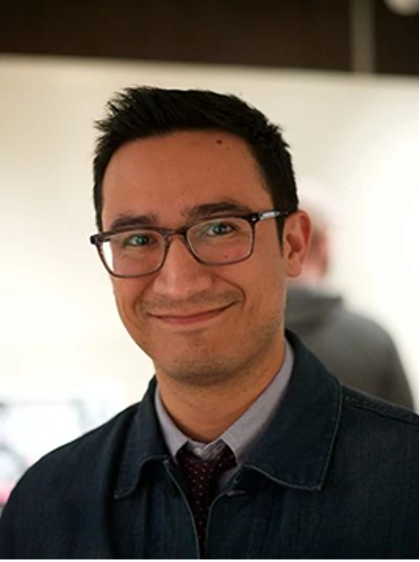By Francisca Aguirre
This Winter we will be publishing a series of spotlight articles about multilingual students and faculty at DU. These articles are based on interviews that Dr. Kamila Kinyon and a group of multilingual students conducted about interviewees’ lived experiences, including continuing connection to heritage languages, role as writers and teachers at DU, and thoughts about multilingual and multicultural identity. This project is funded by a Faculty Research Fund Grant awarded to Dr. Kinyon for 2023-25. We welcome this opportunity to celebrate DU’s multilingual community.
A native English speaker and Spanish speaker by heritage, Esteban Gómez is a professor in the Department of Anthropology at DU. As an American of Mexican descent, Esteban sees his multilingualism as a fundamental part of his identity and journey.
Esteban was born and raised in the LA area of California, in the Inland Empire, to Mexican immigrant parents. When recalling his early experience with multilingualism, Esteban recounts his early childhood memories, when he began navigating the dualities of growing up in a multilingual household in a mixture of English and Spanish, or as he better calls it “Spanglish.” Being the youngest of five siblings, Esteban’s early language learning was heavily influenced by his siblings and parents: “My older siblings spoke only English to me, and my parents only Spanish, so growing up I was able to kind of understand and speak both languages.”
During his early school years, English became Esteban’s dominant language. Although he initially started elementary school in a predominantly Latino school in West Covina, his family then moved to La Verne, where he enrolled in a predominantly white school. There he was placed in an ESL course. Beyond school, Esteban highlights his dad’s efforts in immersing him into speaking English: “For my father, it was really important to make sure that I was as Americanized as I can be. This meant that he tried to encourage me to speak English as much as possible, and in some cases he kind of discouraged me from speaking Spanish.” Despite this, Spanish was occasionally present in his conversations with his dad at home, which Esteban recalls as an “odd kind of linguistic relationship.” In Esteban’s perspective, this dynamic in his household eventually caused him and his older siblings, born in Mexico and taught solely in Spanish for the first four or five years of their lives, to deemphasize Spanish in the process.
Spanish became important to Esteban in college, a space where he strove to keep it alive: “I had to go outside of the house to really strengthen my Spanish ability.” Multilingualism remained an asset during his college years. Esteban, who has a Ph.D. in Anthropology from the University of California, Berkeley, found his passion for archaeology as an undergraduate student at UC Santa Cruz. During this time, he studied abroad in Mexico in a field research program and immersed himself in the language and culture of his place of heritage.
During his time in Mexico, Esteban immersed himself in a two-month language program to help him strengthen his ability in Spanish while navigating anthropological research. This was an experience that he strongly valued when choosing his career path: “That’s when I kind of really knew I wanted to do anthropology and in Latin America.” While abroad, Esteban got the opportunity to significantly improve his Spanish abilities by interacting with people such as his host family and the friends he made along the way, like his dear friend Pepe from Mexico City. The proximity to language and culture that Esteban experienced while abroad helped him self-discover parts of his identity he felt he neglected while growing up in the US: “I started realizing kind of my own identity, or kind of reaffirming who I was as a person, gaining more pride in my cultural background.” It was an experience that in Esteban’s view changed his life and prepared him for his career.
For instance, when asked about his fluency and comfort level in Spanish, Esteban highlights that working in Central America enriched his ability and control of Spanish. He highlights that his experience as an archeological field researcher at the time was influential in helping him master writing technical language and in publishing research in Spanish. But he also mastered communication with his Latin American friends, to the point that he even became proficient in Spanish jargon.
While Esteban is multilingual, he admits that since his years in Central America, his ability and use of Spanish have slowly diminished, except for occasional moments when he speaks with his parents or when visiting scholars from Latin America. He says: “Like any language you have to keep practicing it, and it has to be a daily thing to maintain it.” Despite this, he continues reading and writing in Spanish. In addition, Esteban notes that Spanish comes into play in his English writing style: “I do have a unique writing style that is a little bit more informed by Spanish.” Esteban recognizes this pattern whenever he phrases and structures sentences and paragraphs, a habit influenced by his multilingual background.
While living in the United States has kept Esteban more detached from his Spanish, he finds interactions with his Latin American friends and culture an opportunity to reconnect with his second language. He sees that expressed in the vibrancy of his personality whenever he speaks in Spanish: “When I speak in Spanish and when I interact with other people that are like me, it’s when I become more vibrant…and so when I think about it, it’s taken me maybe forty years to realize this.”
Interestingly, as a digital anthropologist at DU, Esteban produces film projects related to Latino communities. His experience ranges from a project on the impacts of gentrification in Denver and the displacement of Latino communities to his most recent film project called “Todo y Siempre.” A photo workshop series at West High School in the Denver area displays the stories and experiences of recently arrived Venezuelan immigrant students, including the challenges they face due to anti-immigrant public backlash in the media.
When asked about how his multilingualism is present in his current project, Esteban highlights how he mixes both English and Spanish when writing for the project treatment, a type of film script, and in writing certain phrases and words. This is vital in conserving the essence of certain expressions: “There’s just certain things that you have to communicate in Spanish…if you think about it, even the working name of the film, ‘Todo y Siempre,’ if you translate that into English, it just doesn’t sound as impactful.”
Esteban also finds mixing both languages beneficial when creating and writing interview questions for his students. He explains that especially when dealing with Spanish-speaking youth, understanding context matters as well as thinking about language and the nuances within the language to formulate questions and communicate what he desires through them: “Rather than formulate the questions in English, I have to formulate them first in Spanish and so in a lot of ways I think my cultural background helps in terms of understanding that.” In doing so he makes sure that the person reading understands it, especially when translation between languages can completely change meanings in translation. Overall, Esteban considers his multilingual writing and speaking abilities an advantage in understanding different aspects of communication from a multilingual position.
As a faculty member at DU, Esteban recognizes that while the university does provide inclusive spaces for students to share their cultural identities, he worries these spaces are not sufficiently well-resourced. Specifically, with the Spanish-speaking students at DU, Esteban highlights the recent cut of Diversity, Equity, and Inclusion program resources for DU and how these actions display a lack of attention and support: “It’s kind of half-baked, meaning that yes they put some attention and some resources into it, but not what it fully deserves or requires.”
If Esteban can give any advice, it would be encouraging multilingual students, who can sometimes feel out of place, in “taking classes and meeting people that reaffirm who you are as a person and to seek it out as much as you can.” For Esteban, it took him twenty years to realize the value of his Mexican heritage. Its language and culture were the heart of who he was, which is why he believes in the value of engaging with those who share similar backgrounds and life experiences in each student’s journey towards self-discovery.

